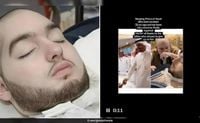In April 2025, Saudi Arabia’s Prince Al-Waleed bin Khaled bin Talal, often referred to as the "Sleeping Prince," marked his 36th birthday, a poignant milestone given his nearly two-decade-long coma. The prince has been unconscious since a severe car accident in 2005 left him with a traumatic brain injury while he was studying at a military college in the United Kingdom. Despite the passage of time, the prince remains on life support at King Abdulaziz Medical City in Riyadh, with no official reports of significant improvement.
However, shortly after his birthday, a video began circulating widely across social media platforms, claiming that the "Sleeping Prince" had miraculously awakened from his coma and was reunited with his family. This video quickly gained traction, stirring hope and excitement among netizens. The clip was often shared alongside a photograph of Prince Al-Waleed, bolstering the false narrative that he had regained consciousness after 20 years.
The viral video, however, was a case of mistaken identity. The footage actually depicted Yazeed Mohamed Al-Rajhi, a prominent Saudi billionaire and motorsport figure, recovering from injuries sustained in a recent car accident. Al-Rajhi and his co-driver, Timo Gottschalk, were involved in a crash during the second and final stage of the Baja Jordan rally in April 2025. Following the accident, both men were hospitalized as a precautionary measure and were reported to be fully conscious and in stable condition.
Yazeed Racing, Al-Rajhi’s official Baja rally team, confirmed on Instagram on April 12 that the pair had been taken to the hospital after the crash. Later updates revealed that Al-Rajhi had suffered fractures in two vertebrae, while Gottschalk endured four spinal fractures. Videos of Al-Rajhi interacting with friends and family during his hospital recovery were shared publicly, which were later mistakenly linked to the narrative of the "Sleeping Prince" awakening.
Prince Al-Waleed’s condition remains grave. He has been on life support for the past 20 years and is fed through a tube. In 2015, doctors recommended disconnecting life support, but his father, Prince Khaled bin Talal, refused to give up hope. “If God had wanted him to die in the accident, he would have been in his grave now,” the prince’s father said, holding on to the possibility of a miracle. In 2019, the prince showed faint signs of response, such as raising a finger or turning his head, but there has been no substantial improvement since then.
Despite the hope and prayers expressed by many on social media during the prince’s birthday, no official sources have confirmed any change in his condition. The misinformation surrounding the viral video highlights the ease with which false narratives can spread online, especially when fueled by emotional investment and hope.
The "Sleeping Prince" is the great-grandson of King Abdulaziz, the founder of modern Saudi Arabia, which adds to the public interest in his fate. His prolonged coma and the steadfastness of his family have made his story a subject of fascination and sympathy both within Saudi Arabia and internationally.
Meanwhile, Yazeed Mohamed Al-Rajhi’s recovery continues to progress, and he has been discharged from the hospital. His story, while inspiring in its own right, is entirely separate from that of Prince Al-Waleed. The viral confusion serves as a reminder to verify information carefully, especially when it concerns sensitive health matters and high-profile individuals.
As of June 2025, Prince Al-Waleed bin Khaled bin Talal remains in a coma, with no confirmed signs of awakening. The viral video that sparked hope and excitement was, in fact, footage of another Saudi figure’s recovery, mistakenly attributed to the prince. The story underscores the power of social media to spread misinformation and the deep human desire to witness stories of recovery and resilience.





